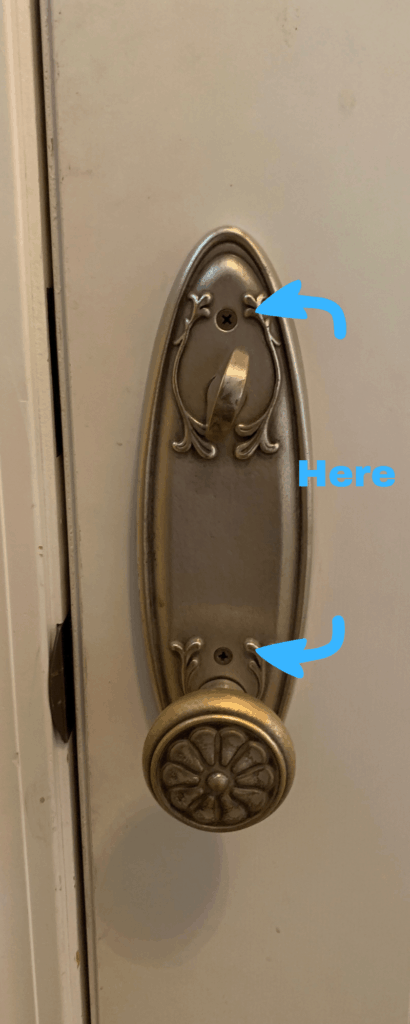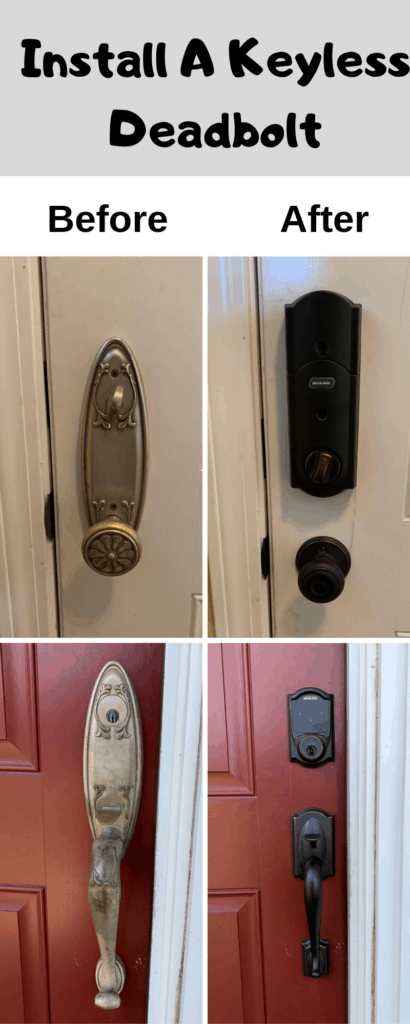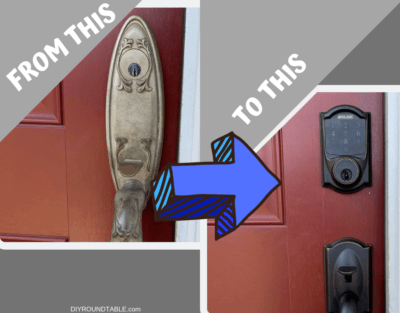This post may contain affiliate links. Please read the disclosure for more info.
Over the years I have seen advancements in technology and while some I thought long and hard about pursuing there are others I just cannot live without. With the obvious exception of home Wi-Fi, I really cannot go a day without having my keyless deadbolt lock on my front door. I use it all the time and have found it to be the best money I spent.
When I am planning a renovation or remodel for a home I make the plan and budget allow for installing a keyless entry deadbolt on the front door. I know for some the thought of installing this technologically advance hardware on the front of your house for the rest of the neighborhood to see can be very intimidating; especially if you’ve never tried to install one before.
Don’t Worry! This post will help you understand the process for installing your new keyless deadbolt lock, provide you with helpful tips for a smooth installation and if you are looking for info before to help you make a purchase be sure you read all the way to the end.
How to install a keyless deadbolt? To install a keyless deadbolt, make sure you check your existing lock and door for the following:

- Ensure the current door can lock and unlock without pulling, pushing, or lifting. You want to ensure the door operates smoothly and easily to allow for the deadbolt lock to extend as designed.
- Ensure the space in the strike plate where the deadbolt will extend has at least 1” of space. This will ensure that when the deadbolt is extended there will not be any interference.
- After you have completed the prior checks ensure you have proper door and frame alignment so you can proceed to install your new keyless deadbolt.
- Once those are done start by removing the existing deadbolt and door handle assembly. This is done by removing the interior screws as seen in the diagram. Also, remove the existing latch and strike plate.

- After you have removed the existing deadbolt you can verify your door and frame dimensions for the crossbore and the backset.
- After you have verified the dimension you can begin installing your new deadbolt. See diagram:
- After confirming your dimensions, you can start by installing the new deadbolt and strike plate for the deadbolt. If your backset is 2 3/8” ensure the new deadbolt is set to the correct length by twisting the faceplate accordingly. Tip – you can change the faceplate on the latch to fit your style by prying it off with a screwdriver.
- Install the faceplate to the door and the strike plate to the door frame.
- Test the deadbolt by closing the door and using a screwdriver to extend the latch and test that you have a smooth operation. If your deadbolt is operating smoothly then continue with the install. If there are issues you will need to check the door alignment for any obstructions.
- Install the touchscreen assembly by feeding
the cable under the deadbolt and pushing the touchscreen assembly into the
door.
Install the support plate on the inside of the door. Tip – take note of the orientation of the support plate and the indentation of the screw holes are facing correctly. - Install the interior assembly by attaching the cable to the connector, feeding the wire through the assembly properly and aligning the hole with the exterior touchscreen assembly latch.
- Install the interior screws.
- Install the necessary batteries.
- Install the battery cover.
- Now you are ready to set up the lock. Start by testing the lock. Use the existing codes and interior thumb turn to ensure you have a smooth operation. If you have issues with the lock, then check for misalignment or an obstruction.
- If the deadbolt operation is smooth you can move on to the installation of the interior and exterior knobs and levers.
- Install the latch, strike plate and face plate as in the prior steps.
- This process may require adjustments if it’s an existing door and most locks come with templates for proper modifications.
- Once this is completed you can install the handset and doorknob by attaching both to the interior and exterior of the door and use the bolts that came with the kit for the install.
Continue reading below for further information on troubleshooting, tips and more details.

Watch the video here on how to install a keyless deadbolt.
Jump To:
How to ensure a smooth installation process for a keyless deadbolt?
Tip – Try to buy a door handle setup that matches your existing door handle so the set up is straightforward and you can avoid drilling or modifying your door.
Tip – For removal and install of a
Tip – Take pics of the codes with your phone or write them down so if you ever need them you have them handy.
Tip – If your newly installed keyless deadbolt is not operating smoothly you may have a strike plate or faceplate that is out of alignment. If this is the case, there are a few things you can do. First, ensure you have removed the old strike plate and faceplate and are using the new strike plate and faceplate. Most new locks come with a matching strike plate and this is not just for style but also to ensure the door lock closes smoothly.
Tip – Ensure you have fresh batteries. Most new locks come with new batteries, but you want to ensure they are fully charged, or you may see issues with the motor locking and unlocking.
Tip – Check the wire is attached to the connector properly and did not come loose during the install.
Tip – Make sure you have a code in mind before starting.
How to program and reset codes for a keyless deadbolt lock?
This process may have slight variations between lock manufactures but for the Schlage Keyless Deadbolt, which is what I installed in the video and photos above, the steps to program a new code are as follows:
Tip: Be sure to have your 6 digit programming code handy!
Touch the Schlage button on the exterior of the door keypad, enter the 6 digit programming code, then type 1 + the new 4 – 8 digit code, re-enter the 4 – 8 digit code, you should hear 2 beeps and see 2 blinks stating it is successful. You can test it right away.
If you want to delete all user codes perform the following:
Warning – once you delete all user codes you cannot retrieve them after!!!
Touch the Schlage Keyless Deadbolt button on the exterior of the door keypad, enter the 6 digit programming code, then type 6 + the 6 digit programming code, you should hear 2 beeps and see 2 blinks stating it is successful. All user codes have been deleted!
Is a new keyless deadbolt lock right for you?
To determine if you should purchase a new keyless deadbolt there are a few things to consider.
First keyless locks are much more convenient than standard locks. Many people would prefer not to carry keys. Also, you will not have to worry about losing keys or someone taking a copy of your key.
If you feel a code was compromised, you can tell the lock to remove the code or all codes to allow you to create new codes.
You can provide a code to a family member, worker, or delivery person and for those old-fashioned family members, most keyless locks still have the keyhole for those that want to use a key.
To reiterate a deadbolt from a keyless lock is no safer than a traditional deadbolt, but a keyless deadbolt offers a huge convenience over the keyed systems.
Many have been in the situation where they find themselves trying to get in the front door, with bags in their hands and don’t want to search for a key in a bag or pocket. With the keyless deadbolt, you can press your code on the lighted keypad with one finger and open the door.
A keyless deadbolt lock can save you the time and cost of getting copies of keys made, recalling who has those copies and allow you to control who has access in your home and when.
Like many technical advancements in our lives today the keyless deadbolt does have options to further the convenience our life like communicating with many smart home devices like Alexa from Amazon or allowing us to open the front door via our smartphone. However, to achieve this you need to pick a protocol like Bluetooth, Z-Wave or Wi-Fi.
How to pick a keyless deadbolt lock protocol? Bluetooth, Z-Wave or Wi-Fi
Keyless deadbolt locks use to three common protocols to communicate with us in our lives: Bluetooth, Z-Wave or Wi-Fi. Each of these protocols have pros and cons so read on to ensure you know the differences before making a purchase.
Bluetooth:
Bluetooth is a common keyless lock protocol and popular for its long battery life compared to Z-Wave or Wi-Fi. Battery life on keyless deadbolts is a huge concern since you use the lock on your door many times per day. You will not want to change batteries monthly! With Bluetooth, the batteries can last up to a year.
One nice benefit to Bluetooth is that certain locks now come with a feature that allows your lock (when in range) with your phone to auto-unlock the front door as you approach it.
The downside to Bluetooth is its range, which maxes out at 250 feet or less based on your homes floor plan. If you are using your phone to connect via Bluetooth to your lock if you are out of range that will not provide you the right access.
Some Bluetooth examples are Nest, Kwikset, Schlage or Kevo.
Z-Wave:
A pro is that Z-Wave products are vast, and the list of third-party products and conveniences continues to grow.
Z-Wave requires a separate hub to help translate the protocol for the rest of
The range for Z-wave is 100 feet which for larger homes can limit the router set up options compared to where the lock is located without purchasing an extender increasing the range to 600 feet.
Some Z-Wave examples are Yale, Kwikset, or Schlage.
Wi-Fi:
Wi-Fi is in almost every home in the modern world!
With
You could communicate with your keyless door lock anywhere in the world where you have an internet signal.
Some Wi-Fi examples are August, Yale, Kwikset, or Schlage.
Can a keyless deadbolt lock be hacked?
Yes, almost any keyless deadbolt lock can be hacked given enough time. I would say the same for a keyed lock on an entry door. A keyless deadbolt door lock is much like many other technological conveniences in our daily lives.
There are precautions manufactures take and there are precautions we as users can continue taking. Such as, ensuring we are using the best codes available. If your keyless lock manufacturer allows between 4 and 8 digits for the pin, I would suggest going to 8. I would also take advantage of two-factor authentication if your lock allows for it.
Best Keyless Deadbolts
According to the article on TheArchitectsGuide, the 10 best keyless deadbolts are ranked with the Schlage Keyless Deadbolt I installed in the article and video ranked as #1.
The Schlage Keyless Deadbolt locks hold the first three spots in the top 10 rankings.
Related posts:
Don’t forget to check us out on social media. Please like and subscribe.

